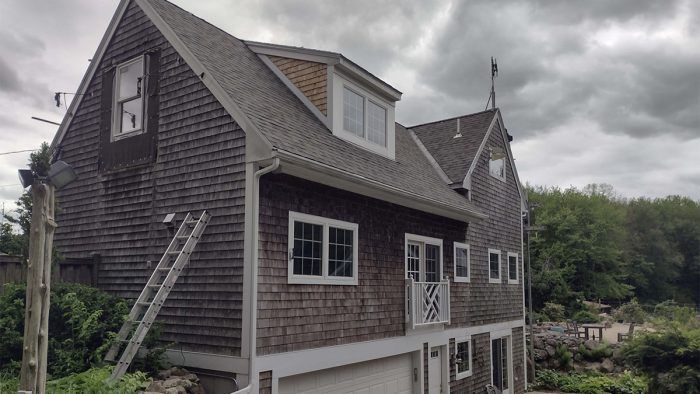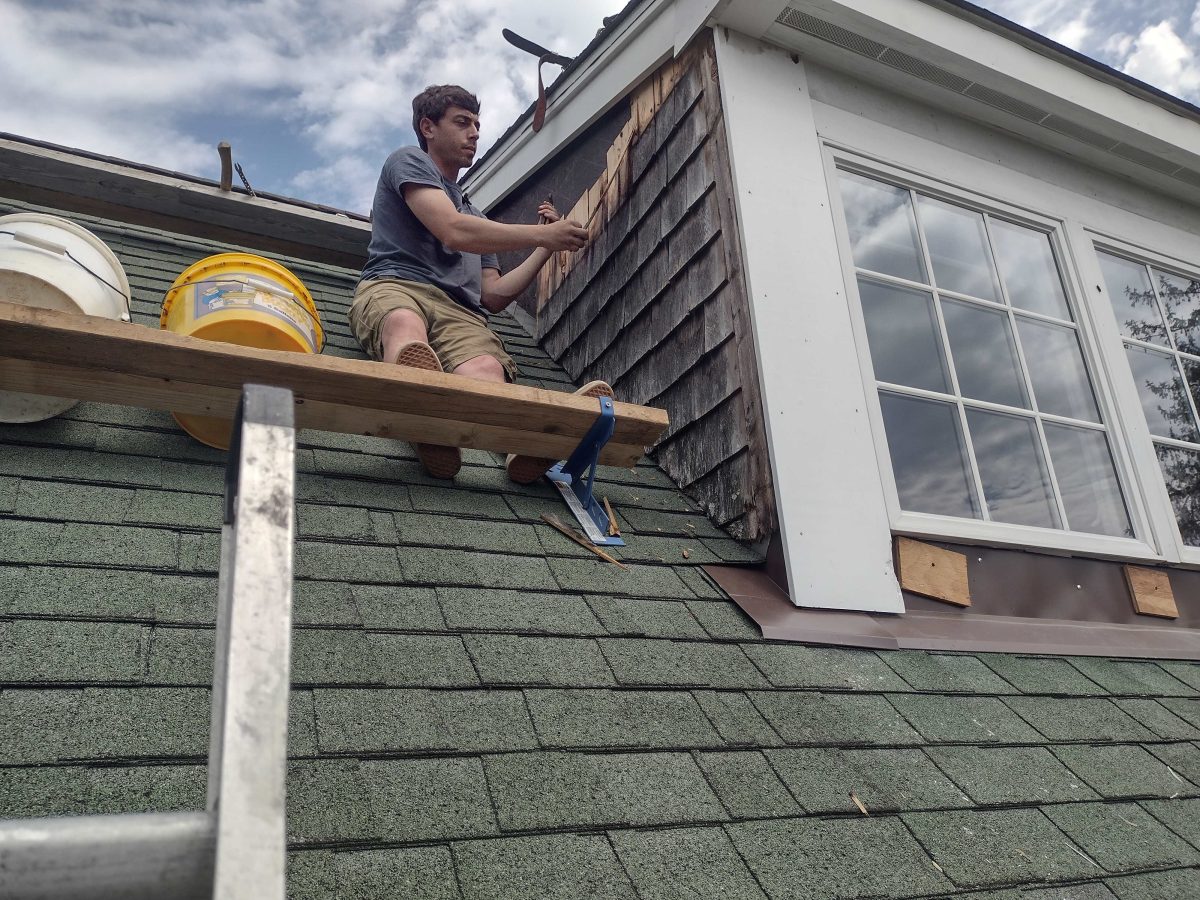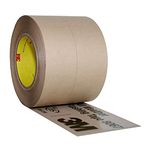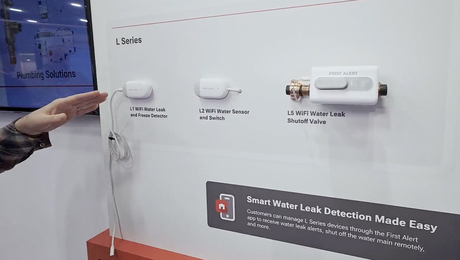Podcast Episode 689: Basement Garages, Compact ERVs, and Safer Paint Stripper
Listeners write in about ventilation and radon control and ask questions about tightening basement garages, ventilation solutions, and safer paint stripper.

Welcome to the Fine Homebuilding podcast, our weekly discussion of building, remodeling, and design topics aimed at anybody who cares deeply about the craft and science of working on houses. This is senior editor Patrick McCombe. I’m joined by Fine Homebuilding editorial advisor Mike Guertin, Fine Homebuilding associate editor Grant Baver, and producer Cari Delahanty. Please email us your questions to [email protected].
You can find previous podcasts and check out the show notes at finehomebuilding.com/podcast
Check In:
Grant: Fight House Fires Through Design
Mike: Shingle siding

Listener Feedback 1:
Greg from Charlton, N.Y., writes:
Hi Patrick and Podcast Crew,
I’m a longtime subscriber and listener of the podcast back to Episode 1. I was listening to Episode 683 this evening when your discussion about ERVs and radon mitigation in a “Barndo” caught my ear. I thought I would write about my own experience using an ERV to mitigate radon in my own house.
A little over a year ago I installed an IAQ monitor from an outfit called Airthings. I am sure you have heard of them, but these nifty gizmos allow homeowners to monitor in real time all sorts of IAQ metrics, including temperature, RH, PM2.5, PM1.0, CO2, VOC, and, yes, radon.
There are little display units you can put on the wall so you can tell when you have company (CO2 is elevated) and when you just sauteed onions (PM2.5 is elevated). Of course, you can also track all these things in real time on your smartphone. I noticed that in the fall and winter the radon level would creep up around 6.0 pCi/L. I suspect elevated levels in the home had something to do with a closed-up house in winter not allowing fresh air to mix in the living space.
I decided to embark on a DIY radon mitigation project. My house in upstate New York has a very old stacked fieldstone foundation. Our best estimate puts it at 200 years old, possibly older. It has been cared for over the years—the joints are well pointed, and it mostly keeps bulk water from intruding. The basement slab is likewise OK—not nearly as old, but not airtight by any means. However, this basement construction makes the house a poor candidate for traditional sub-slab radon mitigation. It is likely that radon is coming through every minuscule crack in the stone walls, or even emitting from the stones themselves.
I instead installed an ERV with dedicated ductwork to vacuum up stale air while introducing fresh air from outside. The solution to pollution is dilution. I bought a Broan AI Series ERV from my local HVAC distributor and installed it with two approximately 25-ft. runs of 6-in. round duct. Radon is many times heavier than air, so I positioned the stale-air intake duct near the floor in the dankest corner of the basement. Fresh air is brought inside and expelled in the vicinity of the central HVAC system return duct, which features a small intake vent in the middle of the basement. I didn’t plumb the fresh-air supply into the HVAC unit because this could cause balancing issues. I figured putting the fresh-air supply just near the house return was good enough.
This technique was not exactly novel—there seems to be some precedent recorded on GBA from installers who experienced mixed results. My results were great. I run the ERV at 80 CFM. My radon levels now live below 2.0 pCi/L in the basement and even less upstairs. I achieved this without any of the back-breaking labor of chipping up my concrete slab and hand-digging a trench for gravel and pipes. Constantly exchanging air in the basement has mitigated more than radon. It has mitigated the dank cellar smell, too.
I think this method for dealing with radon could be useful for other homeowners, especially those of us with colonial era basements. I’d be happy to discuss this further.
Thanks for the work you do helping pros and DIYers alike.
Greg
RELATED STORIES
- Success with Whole-House Ventilation
- Rise of the IAQ Monitor
- Review of the Broan-Nu Tone’s Overture System
- The Air We Breathe
Listener Feedback 2: Radon mitigation systems should be a part of new builds
Guy writes:
Hi Patrick and FHB crew,
I continue to enjoy my weekly deep dive in all things FHB, made even better with my All Access membership. My wife often looks at me with my earbuds in and shakes her head at my grins and laughter and comments “FHB podcast again?”
Anyway, with the discussion of radon, my ears perked up as I wrote my master’s thesis on building a predictive model of radon in new construction based on a soil test. So, the answer to your discussion is yes: you can predict reasonably reliably what radon levels will be in homes using a series of soil tests. I buried alpha track detectors in the soil and was able to correctly predict the radon levels in the home. However, the cost of radon mitigation in new construction is low so you should just plan for it. Because radon is a gas that is mixed in with other soil gasses, it is simple to collect the gas from under a slab and vent to the atmosphere with a PVC pipe penetrating the roof. The stack effect helps create a small negative air pressure that will allow the soil gas to vent harmlessly to the air. After completion of the home, with all HVAC systems in operation, the home radon levels should be checked again. If the levels are close to the EPA design limit of 4 pCi/L, you should add an inline duct fan to increase the negative air pressure under the slab. Those are the basics, but geology and soil conditions can increase or decrease the soil radon migration, so read up on it if you plan to do the job yourself.
Thanks,
Guy
Patrick asks Guy:
Are there any common ways to get them wrong? Do they need regular attention?
What about initial and ongoing testing? I’m familiar with the little canisters that you leave in the space and then send to a lab for determining the presence or amount of radon. Do they work? Are there other ways to test? I’ve heard radon levels often rise after persistent or heavy rain. As I understand it, the theory is that groundwater displaces the gases in the soil. Are these limited exposures a worry? Thanks for any info.
Guy responds:
Yes, the system I was referring to is a high-permeability aggregate under the slab with the slab being the cap. The 4-in. vent pipe goes through the roof to take advantage of the stack effect. The only thing to get wrong is not having good communication with the gravel and vent. The vent must be able to develop a lower air pressure than the common home negative air pressure from HVAC systems operation.
You all gave good advice to look at the radon maps and talk to neighbors. However, there are outlier areas that can have elevated radon that are not associated with geology, so it is a good idea to test. A long-term alpha track test is best over 3 to 12 months. It works kind of like an x-ray film capturing the evidence of the alpha particle impacts. Long-term testing helps eliminate false negative or positive readings from three-day tests since the migration of soil gas is impacted by barometric pressure, snow cover, and soil moisture.
Radon is a real health threat (with lots of data from miners’ exposure) and is relatively easy to mitigate. The alpha particle emissions from radon as the element moves down the periodic table to a stable element can cause cell damage in the lungs leading to lung cancer. We are exposed to so many environmental issues it is easy to overlook radon, but it is something that can be managed.
Thanks,
Guy
RELATED STORIES
- The Basics of Radon Mitigation
- Review of the Wave radon monitor from Airthings
- GBA: Radon Mitigation
Question 1: What’s the best way to insulate and air-seal a basement garage?
Matt writes:
Hi Everyone,
I have a 1956 ranch in southeastern Michigan that is slab-on-grade with a tuck-under garage (poured-concrete walls) that acts like a garage and partial basement. This space contains the water heater, furnace, space for a single car, and limited storage. Above this space is a living room. I noticed recently that the previous homeowner had installed fiberglass insulation in the rim joists. I tore down the drywall and redid the insulation with foam board and spray foam around the edges.
While doing this, I also noticed that the entire ceiling is simply drywall and fiberglass insulation. I think I should redo this and better seal off the garage space from the living room. What do you recommend? The ceiling is already pretty low so I don’t want to increase the thickness beyond new drywall. My goal is keep the living room a little warmer, especially in the winter months.
Thank you,
Matt
RELATED STORIES
Question 2: Are single-room ERVs a reasonable option?
Alec writes:
Hello podcast team,
I’ve been listening to your podcast while we’ve been building our own home in southern Vermont. In Episode 684, someone had written in asking how they should handle their fresh air supply after forgetting to plan for ERV ducts.
One possibility to consider would be running single-room ERVs throughout the house. These products go directly through the exterior wall and use ceramic cores to retain temperature as they cycle air back and forth. You can often pair these units together for fine-grained control over air supply and pressure throughout the house. From an engineering perspective, this has some appeal, especially when compared to centralized systems that can be tricky to calibrate. Not to mention, they are very easy to clean and maintain. If a single unit fails you still have a functioning system.
There are, of course, downsides: you need to seal all those extra penetrations and you now have a bunch of extra vents on the exterior of your house. It can be more expensive than a centralized system, but not necessarily. Lunos and Vents-US are two major suppliers, but we went with the Airwoods units, which are a fraction of the cost. I’ve been impressed with the build quality, particularly the electronics.
Curious what the podcast team thinks about these and thought it was worth discussing this option.
Thanks for the fantastic show,
Alec
- Monitoring Indoor Air Quality
- GBA: Lunos Compact ERV Video with Josh Oduin
- GBA: Zehnder Develops a Ductless ERV
Question 3: Listeners, what are your recommendations for paint strippers?
Patrick asks:
Somewhat regrettably, I’ve offered to test modern paint strippers for Fine Homebuilding.
In 2019: the EPA finalized a ban on consumer use of methylene chloride in paint and coating removers. On July 8, 2024, the final rule was published in the Federal Register and became effective. This was followed by a ban on all consumer use of methylene chloride with a compliance deadline of May 5, 2025.
I would love to hear about listeners’ experience with non-methylene chloride paint strippers to better inform our editorial content on the subject. If you’ve used one of these products, I would be grateful if you’d write in describing what product you used, what you were stripping, and any tips or cautions you have.
Sign Up for an All-Access Membership.
Thanks to Mike, Grant, and Cari for joining me and thanks to all of you for listening. Remember to send us your questions and suggestions to [email protected] and please like, comment, or review us no matter how you’re listening–it helps other folks find our podcast.
Happy Building!
Fine Homebuilding Recommended Products
Fine Homebuilding receives a commission for items purchased through links on this site, including Amazon Associates and other affiliate advertising programs.

Affordable IR Camera

8067 All-Weather Flashing Tape

Reliable Crimp Connectors


























